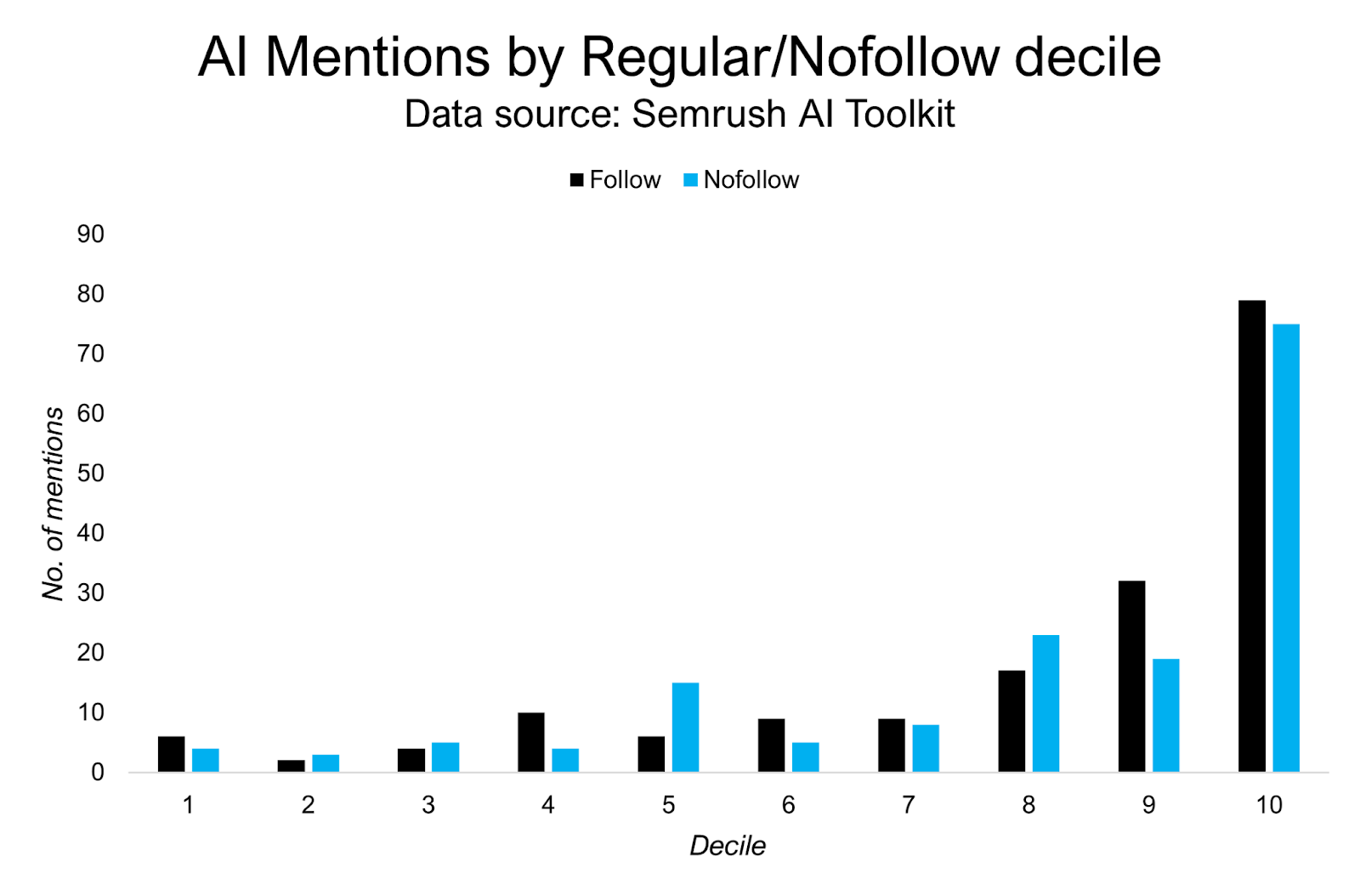As AI Dominates Search, Where Does Link Building Fit In?
-

Jonas Trinidad
- Blogs
-
 November 05 , 2025
November 05 , 2025 -
 10 min read
10 min read
Link building is NO-BS Marketplace’s bread and butter. Our approach to content creation revolves around making content worthy of being published by respectable publisher sites, according to your niche. The more reputable the publisher, the greater the chances of your content ranking high in search results.
Well, that’s how it used to work.
If you’ve been following SEO news closely, you’ll know that artificial intelligence (AI) has been quite the industry disruptor. In addition to search engines introducing AI-generated summaries, AI tools like ChatGPT and Perplexity are creating answers that eliminate the need to browse their sources. Naturally, this has left publishers peeved.
It goes without saying that all of SEO is at the mercy of AI, forcing another overhaul of the current playbook. Link building is no exception, for better or worse. That said, where will this PageRank-era practice fit in this AI-dominated world?
Link Building Goals
Before we get into the nitty-gritty, we first need to gain a clear understanding of the purpose of link building. If your answer is to boost a site or page’s chances of ranking close to the top, that would’ve been right in the early 2000s because that’s what PageRank was for.
However, after the great shift from quantity to quality in the early 2010s, link building is less math and more reading. The goal is no longer to rank by placing as many backlinks as the content can hold, but rather to ensure they’re helpful. A single relevant backlink from a high authority source is worth more than several poor-quality ones from a dubious source.
While proper link building doesn’t guarantee a high rank, let alone the top, it’s more about building credibility. Think about it: if you know that the second-ranked result satisfies your curiosity more than the top-ranked one, you’ll likely choose that. No amount of algorithmic code will convince you otherwise because it can’t recognize nuance.
Here’s an example: searching for “what is cryptocurrency” shows that a Wikipedia entry is the top-ranked result. However, as a writer, I want my information to come from a firsthand source. Wikipedia won’t cut it, as it’s more of an encyclopedia than a financial website.

The Investopedia page, on the other hand, is a financial website and, thus, better suited to discussing cryptocurrency. Also, while not shown above, a result from the crypto exchange website Coinbase is among the top 10 and is a more reliable source.
Even the AI Overview seems to agree, as its list of sources includes both, but not Wikipedia.

But I get you: AI is fueling the zero-click trend that has publishers and businesses freaking out. For that, the bad news is that there’s little we can do to stop AI search from becoming the norm. That said, just as we did in major disruptions to SEO in the past, we can adapt to it by understanding how link building can still work in AI search.
Nofollow: The Secret Sauce?
Early in October, Kevin Indig over at Growth Memo published what may just be the first in-depth study into the impact of backlinks on AI search visibility. The study examined about 35,000 datapoints from AI mentions for 1,000 random domains. In addition to Google’s AI Overviews, he also gathered AI mentions from ChatGPT, Gemini, and Perplexity.
You can click here to check out the study in its entirety, but his findings were eye-opening. Let’s start with the use of follow and nofollow links.
Based on the datapoints, Indig discovered that the use of either type of backlink doesn’t matter. Despite the vast gap between AI mentions among some deciles (groups of 10% of datapoints), the winners for each decile vary too much to make any meaningful difference.

Source: Growth Memo
Google introduced the nofollow attribute in 2005 to fight SEO spam. It works by notifying the crawler not to follow the linked page to avoid penalizing it by mistake. The attribute is standard for paid links, user-generated content (UGC), and duplicate content.
Indig explains that the AI tools weigh nofollow links differently. AI Overviews and Perplexity weigh follow links more, whereas ChatGPT and Gemini do the opposite. He thinks that the preference boils down to the search engine they use, like ChatGPT using Bing, which favors nofollow links (though he stresses that it’s only a theory).
AI Overviews and Gemini, both Google products, are a different story. Nofollow was previously a directive, but in 2020, a major algorithm update reclassified it as a hint. It still follows the nofollow directive, but starting that year, it would consider the tag if there’s something valuable to be gained by following the link. (1)
Between this and the study’s findings, it seems that using nofollow is more beneficial. The tag still works as intended, but large language models (LLMs) aren’t concerned with how a page ranks. Instead, they focus on how relevant its content is to the query.
Meanwhile, content containing nofollow links is less likely to be penalized. Whether or not Google checks these backlinks for good measure, they’re still sending traffic to your site. It’s not as if human readers follow a nofollow directive when they see one.
Image Link Building: A Rising Trend?
We often discuss link building in the context of text-based content. After all, text anchors require less effort to create and optimize for search because all you need to do is type the words. On the other hand, image link building requires creating an infographic or other image-based content, and not everyone is skilled enough to do so.
However, AI has made image link building worth considering. Indig’s study also discovered that image links have a higher chance of being mentioned in AI summaries than text links. This is the case across all five tools, but is most prominent in AI Overviews and Perplexity.

Source: Growth Memo
In fact, we should be using image link building more because of how our brains work. Many studies show that the human brain processes visuals faster than text because it works as it sees. As a result, a person can get an idea of what an image is in as fast as 80 milliseconds, faster than the blink of an eye. (2)
On the other hand, the brain processes lines of text word by word and predicts what word will come next. At its fastest, it can only get an idea of a word in 250 milliseconds and a sentence in 1.25 seconds. (3)(4)
Before AI, image link building remained vastly underused because search engines lacked the tech to crawl text in images. The only viable method back then involved integrating the keyword into the alt text, title, description, and file name. Optimizing an infographic or image that took days to make didn’t seem worth the effort.
To that end, the strong correlation we see with AI tools is likely linked to their capabilities. One key aspect is computer vision, which is responsible for building LLMs to identify and comprehend visual data. Optical character recognition is one such capability, and it’s the same tech used to convert paper files into electronic ones.
This doesn’t mean images are now suddenly better than text. Indig stresses that image link building only pays dividends for sites with moderate authority or higher. It won’t be worth it for sites that have just gone live or are still building their authority.
LLMs Cite Sources Differently
With traditional SEO, most optimization efforts focus on ensuring content ranks high on the Big G. Despite its competitors being the most used in some countries, Google still holds a monopoly on the global market.
While it may seem that the same can be said for LLMs, the situation is less one-sided than you may think. The latest data from StatCounter reports that ChatGPT dominates the LLM market with a global share of over 80%. But unlike search engines, LLMs are multiplying at an unprecedented rate as everyone wants a slice of that lucrative AI pie. (5)
OpenAI will be up against way more competitors than Google has over the decades, and it can’t afford to be seen as a monopoly. Meanwhile, increased consumer awareness means they’ll demand more options other than ChatGPT.
For you, this means maximizing your content’s AI mentions in as many LLMs as possible. To achieve that, it pays to understand how each model retrieves information. Fortunately, a study by Rankscale.ai has covered that. (6)
| Criteria | GPT-4o (OpenAI) | Flash 2.0 (Gemini) | Sonar Mode (Perplexity) | AI Overviews (Google) |
| Most cited domain | Wikipedia | YouTube | Expertise sites (general) | |
| Most cited content type | Blog posts, news articles | Blog posts, news articles | Blog posts, news articles | Blog posts, news articles |
| Least cited content type | Vendor blogs, product pages | User-generated content | User-generated content | Product blogs |
| Avoided content type | User-generated content | Wikipedia entries | Low-quality sources | Wikipedia entries |
Based on the table above, we can make out a few key takeaways.
First, all models like to get their information from blog posts and news articles, as was the case pre-AI. This, in addition to the fact that writers like me won’t be out of a job anytime soon, further solidifies the need for text-based content. Although ChatGPT leans slightly toward news articles, the others overwhelmingly favor blog posts.
Second, the effectiveness of user-generated content varies among the four models. It’s most viable in AI Overviews, especially Reddit, but not so much for the others. Still, they may appear in queries asking for product comparisons or reviews, so it pays not to rule them out of your SEO strategy.
Lastly, direct advertising isn’t as effective as informational content. This is evident in the LLMs’ decreasing favoring of vendor blog posts and product pages. While product pages are still necessary for offering goods, optimizing them is less of a priority compared to off-page articles and blog posts.
Link Building is Still Alive in the AI Era
Publishers and website owners continue to trust link building, perhaps even more in an AI-dominated search landscape. While the goal has shifted from achieving high search rankings to securing AI mentions, the core principle of link building remains the same. It’s all about being seen as a reliable source of niche expertise.
References
1. “Evolving ‘nofollow’ – new ways to identify the nature of links,” Source:https://developers.google.com/search/blog/2019/09/evolving-nofollow-new-ways-to-identify
2. “How the brain stays in sync with the real world,” Source:https://pmc.ncbi.nlm.nih.gov/articles/PMC9851611/
3. “Can Your Brain Read Faster Than You Speak?” Source:https://www.theneurotimes.com/can-your-brain-read-faster-than-you-speak/
4.“Our brains can understand written sentences in the ‘blink of an eye,’ study reveals,” Source:https://www.livescience.com/health/neuroscience/our-brains-can-understand-written-sentences-in-the-blink-of-an-eye-study-reveals
5. “AI Chatbot Market Share Worldwide – Sept 2024 – Sept 2025,” Source:https://gs.statcounter.com/ai-chatbot-market-share
6. “How to get cited by AI: SEO insights from 8,000 AI citations,” Source:https://searchengineland.com/how-to-get-cited-by-ai-seo-insights-from-8000-ai-citations-455284
Subscribe to Our Blog
Stay up to date with the latest marketing, sales, service tips and news.
Sign Up
"*" indicates required fields


